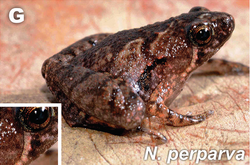Biology:Nanohyla perparva
| Nanohyla perparva | |
|---|---|

| |
| Nanohyla perparva from Gunung Mulu, Sarawak, Malaysia | |
| Scientific classification | |
| Domain: | Eukaryota |
| Kingdom: | Animalia |
| Phylum: | Chordata |
| Class: | Amphibia |
| Order: | Anura |
| Family: | Microhylidae |
| Genus: | Nanohyla |
| Species: | N. perparva
|
| Binomial name | |
| Nanohyla perparva (Inger and Frogner, 1979)
| |
| Synonyms[2] | |
| |
Nanohyla perparva is a diminutive species of frog in the family Microhylidae.[2][3][4] It is endemic to Borneo and found in Kalimantan (Indonesia), Brunei, and Sabah and Sarawak (Malaysia).[1] The nominal species includes distinct lineages that likely represent different species.[2][3] Common names least narrow-mouthed frog[4] and Labang forest rice frog have been proposed for this species.[1][2]
Taxonomy
N. perparva was formerly placed in the genus Microhyla, but a 2021 study using morphological and phylogenetic evidence moved nine species (including N. perparva) to a new genus, Nanohyla.[2][5]
Description
Adult males measure 10.5–11.9 mm (0.4–0.5 in) and adult females 12.4–14.5 mm (0.5–0.6 in) in snout–vent length.[3] The hands have only three fingers. The toe tips are expanded. Colouration consists of shades of brown above, with dark markings on the shoulders and a light band on the flanks.[4]
The tadpoles are very delicate and mostly transparent but appear dark grey when viewed from above. The tail terminates in a flagellum.[4]
Habitat and conservation
Nanohyla perparva occurs in primary lowland rainforests at elevations below 250 m (820 ft). Adults live in the leaf litter and reproduce in both large and small rainwater pools.[1] It can be very abundant after heavy rains when males congregate in water filled depressions and fight for females. The tadpoles are mid-water suspension feeders.[4]
This species is threatened by clear-cutting and conversion of forests into oil palm plantations. It is present in a number of protected areas.[1]
References
- ↑ 1.0 1.1 1.2 1.3 1.4 IUCN SSC Amphibian Specialist Group (2018). "Nanohyla perparva". IUCN Red List of Threatened Species 2018: e.T57888A114919580. doi:10.2305/IUCN.UK.2018-1.RLTS.T57888A114919580.en. https://www.iucnredlist.org/species/57888/114919580. Retrieved 16 November 2021.
- ↑ 2.0 2.1 2.2 2.3 2.4 Frost, Darrel R. (2021). "Nanohyla perparva (Inger and Frogner, 1979)". Amphibian Species of the World: An Online Reference. Version 6.1. American Museum of Natural History. doi:10.5531/db.vz.0001. https://amphibiansoftheworld.amnh.org/Amphibia/Anura/Microhylidae/Microhylinae/Nanohyla/Nanohyla-perparva.
- ↑ 3.0 3.1 3.2 Gorin, Vladislav A.; Solovyeva, Evgeniya N.; Hasan, Mahmudul; Okamiya, Hisanori; Karunarathna, D.M.S. Suranjan; Pawangkhanant, Parinya; de Silva, Anslem; Juthong, Watinee et al. (2020). "A little frog leaps a long way: compounded colonizations of the Indian Subcontinent discovered in the tiny Oriental frog genus Microhyla (Amphibia: Microhylidae)". PeerJ 8: e9411. doi:10.7717/peerj.9411. PMID 32685285.
- ↑ 4.0 4.1 4.2 4.3 4.4 "Microhyla perparva (Least Narrow-mouthed Frog)". Frogs of Borneo – The frogs of East Malaysia and their larval forms. 2021. http://frogsofborneo.org/microhylidae/256-microhylidae/microhyla/perparva/211-microhylaperparva.
- ↑ Gorin, Vladislav A.; Scherz, Mark D.; Korost, Dmitriy V.; Poyarkov, Nikolay A. (2021-12-01). "Consequences of parallel miniaturisation in Microhylinae (Anura, Microhylidae), with the description of a new genus of diminutive South East Asian frogs" (in en). Zoosystematics and Evolution 97 (1): 21–54. doi:10.3897/zse.97.57968. https://zse.pensoft.net/article/57968/.
Wikidata ☰ Q104843224 entry
 |


